Daniel Cremers
LADB: Latent Aligned Diffusion Bridges for Semi-Supervised Domain Translation
Sep 10, 2025Abstract:Diffusion models excel at generating high-quality outputs but face challenges in data-scarce domains, where exhaustive retraining or costly paired data are often required. To address these limitations, we propose Latent Aligned Diffusion Bridges (LADB), a semi-supervised framework for sample-to-sample translation that effectively bridges domain gaps using partially paired data. By aligning source and target distributions within a shared latent space, LADB seamlessly integrates pretrained source-domain diffusion models with a target-domain Latent Aligned Diffusion Model (LADM), trained on partially paired latent representations. This approach enables deterministic domain mapping without the need for full supervision. Compared to unpaired methods, which often lack controllability, and fully paired approaches that require large, domain-specific datasets, LADB strikes a balance between fidelity and diversity by leveraging a mixture of paired and unpaired latent-target couplings. Our experimental results demonstrate superior performance in depth-to-image translation under partial supervision. Furthermore, we extend LADB to handle multi-source translation (from depth maps and segmentation masks) and multi-target translation in a class-conditioned style transfer task, showcasing its versatility in handling diverse and heterogeneous use cases. Ultimately, we present LADB as a scalable and versatile solution for real-world domain translation, particularly in scenarios where data annotation is costly or incomplete.
ECHO: Ego-Centric modeling of Human-Object interactions
Aug 29, 2025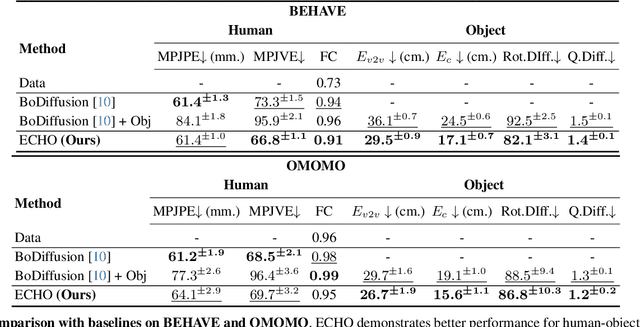
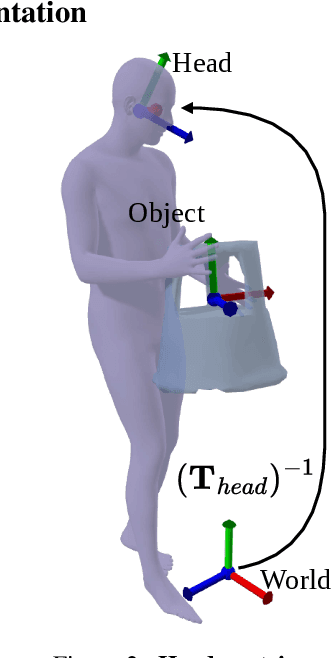
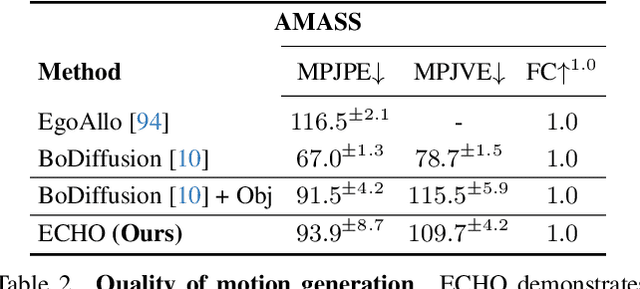
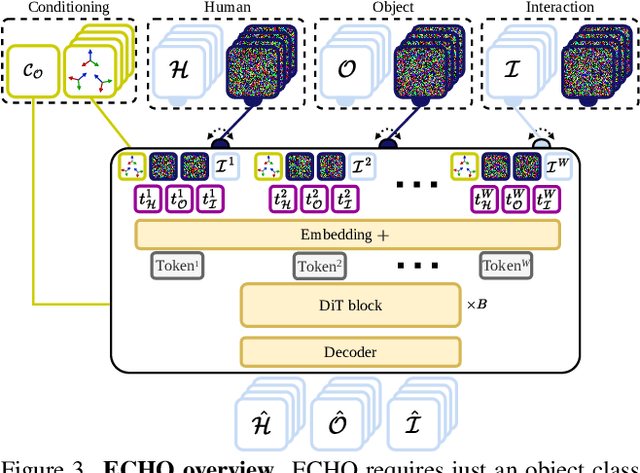
Abstract:Modeling human-object interactions (HOI) from an egocentric perspective is a largely unexplored yet important problem due to the increasing adoption of wearable devices, such as smart glasses and watches. We investigate how much information about interaction can be recovered from only head and wrists tracking. Our answer is ECHO (Ego-Centric modeling of Human-Object interactions), which, for the first time, proposes a unified framework to recover three modalities: human pose, object motion, and contact from such minimal observation. ECHO employs a Diffusion Transformer architecture and a unique three-variate diffusion process, which jointly models human motion, object trajectory, and contact sequence, allowing for flexible input configurations. Our method operates in a head-centric canonical space, enhancing robustness to global orientation. We propose a conveyor-based inference, which progressively increases the diffusion timestamp with the frame position, allowing us to process sequences of any length. Through extensive evaluation, we demonstrate that ECHO outperforms existing methods that do not offer the same flexibility, setting a state-of-the-art in egocentric HOI reconstruction.
GECO: Geometrically Consistent Embedding with Lightspeed Inference
Aug 01, 2025Abstract:Recent advances in feature learning have shown that self-supervised vision foundation models can capture semantic correspondences but often lack awareness of underlying 3D geometry. GECO addresses this gap by producing geometrically coherent features that semantically distinguish parts based on geometry (e.g., left/right eyes, front/back legs). We propose a training framework based on optimal transport, enabling supervision beyond keypoints, even under occlusions and disocclusions. With a lightweight architecture, GECO runs at 30 fps, 98.2% faster than prior methods, while achieving state-of-the-art performance on PFPascal, APK, and CUB, improving PCK by 6.0%, 6.2%, and 4.1%, respectively. Finally, we show that PCK alone is insufficient to capture geometric quality and introduce new metrics and insights for more geometry-aware feature learning. Link to project page: https://reginehartwig.github.io/publications/geco/
The Monado SLAM Dataset for Egocentric Visual-Inertial Tracking
Jul 31, 2025Abstract:Humanoid robots and mixed reality headsets benefit from the use of head-mounted sensors for tracking. While advancements in visual-inertial odometry (VIO) and simultaneous localization and mapping (SLAM) have produced new and high-quality state-of-the-art tracking systems, we show that these are still unable to gracefully handle many of the challenging settings presented in the head-mounted use cases. Common scenarios like high-intensity motions, dynamic occlusions, long tracking sessions, low-textured areas, adverse lighting conditions, saturation of sensors, to name a few, continue to be covered poorly by existing datasets in the literature. In this way, systems may inadvertently overlook these essential real-world issues. To address this, we present the Monado SLAM dataset, a set of real sequences taken from multiple virtual reality headsets. We release the dataset under a permissive CC BY 4.0 license, to drive advancements in VIO/SLAM research and development.
Advancing Robustness in Deep Reinforcement Learning with an Ensemble Defense Approach
Jul 22, 2025Abstract:Recent advancements in Deep Reinforcement Learning (DRL) have demonstrated its applicability across various domains, including robotics, healthcare, energy optimization, and autonomous driving. However, a critical question remains: How robust are DRL models when exposed to adversarial attacks? While existing defense mechanisms such as adversarial training and distillation enhance the resilience of DRL models, there remains a significant research gap regarding the integration of multiple defenses in autonomous driving scenarios specifically. This paper addresses this gap by proposing a novel ensemble-based defense architecture to mitigate adversarial attacks in autonomous driving. Our evaluation demonstrates that the proposed architecture significantly enhances the robustness of DRL models. Compared to the baseline under FGSM attacks, our ensemble method improves the mean reward from 5.87 to 18.38 (over 213% increase) and reduces the mean collision rate from 0.50 to 0.09 (an 82% decrease) in the highway scenario and merge scenario, outperforming all standalone defense strategies.
Feed-Forward SceneDINO for Unsupervised Semantic Scene Completion
Jul 08, 2025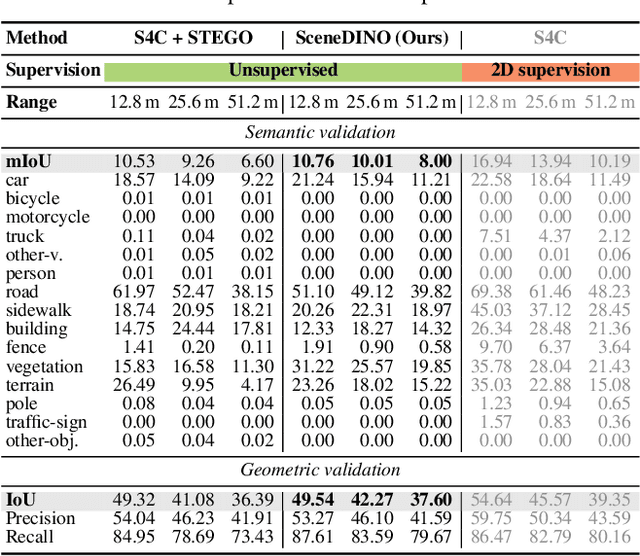


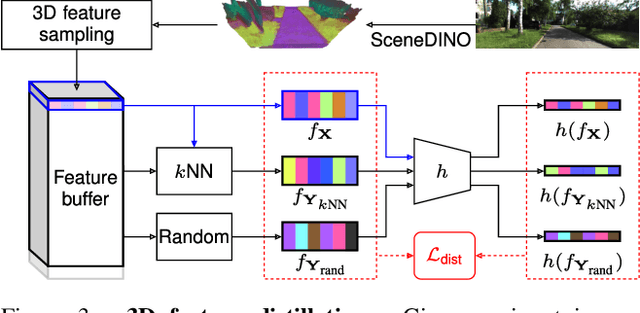
Abstract:Semantic scene completion (SSC) aims to infer both the 3D geometry and semantics of a scene from single images. In contrast to prior work on SSC that heavily relies on expensive ground-truth annotations, we approach SSC in an unsupervised setting. Our novel method, SceneDINO, adapts techniques from self-supervised representation learning and 2D unsupervised scene understanding to SSC. Our training exclusively utilizes multi-view consistency self-supervision without any form of semantic or geometric ground truth. Given a single input image, SceneDINO infers the 3D geometry and expressive 3D DINO features in a feed-forward manner. Through a novel 3D feature distillation approach, we obtain unsupervised 3D semantics. In both 3D and 2D unsupervised scene understanding, SceneDINO reaches state-of-the-art segmentation accuracy. Linear probing our 3D features matches the segmentation accuracy of a current supervised SSC approach. Additionally, we showcase the domain generalization and multi-view consistency of SceneDINO, taking the first steps towards a strong foundation for single image 3D scene understanding.
IPFormer: Visual 3D Panoptic Scene Completion with Context-Adaptive Instance Proposals
Jun 25, 2025Abstract:Semantic Scene Completion (SSC) has emerged as a pivotal approach for jointly learning scene geometry and semantics, enabling downstream applications such as navigation in mobile robotics. The recent generalization to Panoptic Scene Completion (PSC) advances the SSC domain by integrating instance-level information, thereby enhancing object-level sensitivity in scene understanding. While PSC was introduced using LiDAR modality, methods based on camera images remain largely unexplored. Moreover, recent Transformer-based SSC approaches utilize a fixed set of learned queries to reconstruct objects within the scene volume. Although these queries are typically updated with image context during training, they remain static at test time, limiting their ability to dynamically adapt specifically to the observed scene. To overcome these limitations, we propose IPFormer, the first approach that leverages context-adaptive instance proposals at train and test time to address vision-based 3D Panoptic Scene Completion. Specifically, IPFormer adaptively initializes these queries as panoptic instance proposals derived from image context and further refines them through attention-based encoding and decoding to reason about semantic instance-voxel relationships. Experimental results show that our approach surpasses state-of-the-art methods in overall panoptic metrics PQ$^\dagger$ and PQ-All, matches performance in individual metrics, and achieves a runtime reduction exceeding 14$\times$. Furthermore, our ablation studies reveal that dynamically deriving instance proposals from image context, as opposed to random initialization, leads to a 3.62% increase in PQ-All and a remarkable average improvement of 18.65% in combined Thing-metrics. These results highlight our introduction of context-adaptive instance proposals as a pioneering effort in addressing vision-based 3D Panoptic Scene Completion.
ProBA: Probabilistic Bundle Adjustment with the Bhattacharyya Coefficient
May 27, 2025Abstract:Classical Bundle Adjustment (BA) methods require accurate initial estimates for convergence and typically assume known camera intrinsics, which limits their applicability when such information is uncertain or unavailable. We propose a novel probabilistic formulation of BA (ProBA) that explicitly models and propagates uncertainty in both the 2D observations and the 3D scene structure, enabling optimization without any prior knowledge of camera poses or focal length. Our method uses 3D Gaussians instead of point-like landmarks and we introduce uncertainty-aware reprojection losses by projecting the 3D Gaussians onto the 2D image space, and enforce geometric consistency across multiple 3D Gaussians using the Bhattacharyya coefficient to encourage overlap between their corresponding Gaussian distributions. This probabilistic framework leads to more robust and reliable optimization, even in the presence of outliers in the correspondence set, reducing the likelihood of converging to poor local minima. Experimental results show that \textit{ProBA} outperforms traditional methods in challenging real-world conditions. By removing the need for strong initialization and known intrinsics, ProBA enhances the practicality of SLAM systems deployed in unstructured environments.
Prototype Augmented Hypernetworks for Continual Learning
May 13, 2025Abstract:Continual learning (CL) aims to learn a sequence of tasks without forgetting prior knowledge, but gradient updates for a new task often overwrite the weights learned earlier, causing catastrophic forgetting (CF). We propose Prototype-Augmented Hypernetworks (PAH), a framework where a single hypernetwork, conditioned on learnable task prototypes, dynamically generates task-specific classifier heads on demand. To mitigate forgetting, PAH combines cross-entropy with dual distillation losses, one to align logits and another to align prototypes, ensuring stable feature representations across tasks. Evaluations on Split-CIFAR100 and TinyImageNet demonstrate that PAH achieves state-of-the-art performance, reaching 74.5 % and 63.7 % accuracy with only 1.7 % and 4.4 % forgetting, respectively, surpassing prior methods without storing samples or heads.
OPAL: Visibility-aware LiDAR-to-OpenStreetMap Place Recognition via Adaptive Radial Fusion
Apr 30, 2025Abstract:LiDAR place recognition is a critical capability for autonomous navigation and cross-modal localization in large-scale outdoor environments. Existing approaches predominantly depend on pre-built 3D dense maps or aerial imagery, which impose significant storage overhead and lack real-time adaptability. In this paper, we propose OPAL, a novel network for LiDAR place recognition that leverages OpenStreetMap (OSM) as a lightweight and up-to-date prior. Our key innovation lies in bridging the domain disparity between sparse LiDAR scans and structured OSM data through two carefully designed components. First, a cross-modal visibility mask that identifies maximal observable regions from both modalities to guide feature learning. Second, an adaptive radial fusion module that dynamically consolidates radial features into discriminative global descriptors. Extensive experiments on the KITTI and KITTI-360 datasets demonstrate OPAL's superiority, achieving 15.98% higher recall at @1m threshold for top-1 retrieved matches, along with 12x faster inference speed compared to the state-of-the-art approach. Code and datasets will be publicly available.
 Add to Chrome
Add to Chrome Add to Firefox
Add to Firefox Add to Edge
Add to Edge